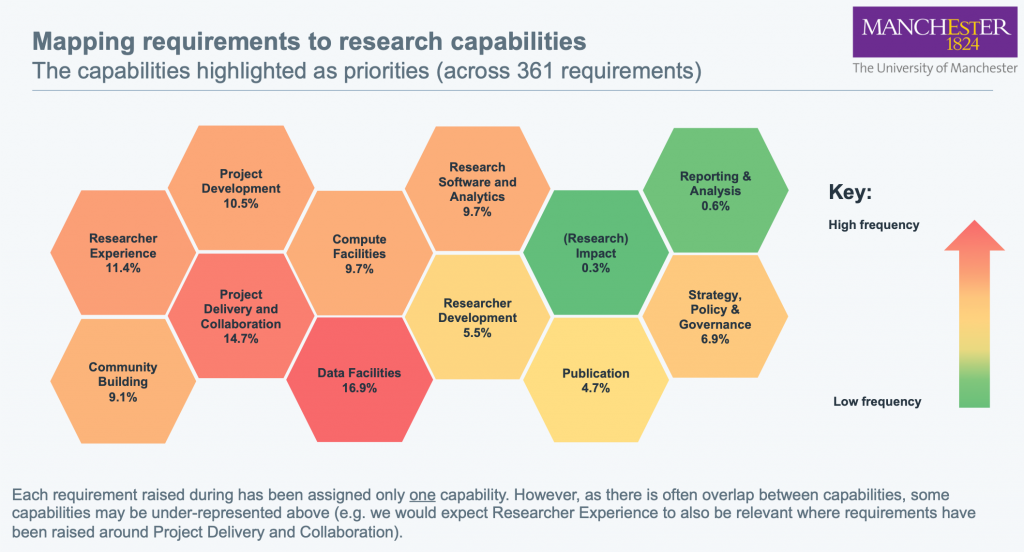
What RLP2 needs to address
In 2022 the Programme began an extensive scoping exercise to help understand how RLP and its successors could continue to grow support for the research and Professional Service communities.
Over 15 weeks the Programme arranged and hosted workshops, interviews and surveys to help gather requirements. This resulted in more than 800 responses that identified:
- 361 requirements
- 55 unique requirements
- 22 priority areas
This was fairly evenly split between the University’s faculties with 30% coming from FBMH, 30% from FSE, and the remaining 40% coming from Humanities.
For convenience, this feedback was initially organised under the existing RLP workstreams as follows:
Research Information
- Knowledge and Information Management practices – better interlinked systems for ease of finding / tracking data
- UOM Intranet – out of date and needs a clearer structure
- Data analytics – legacy systems hinder investment in AI/machine-learning/data science
- HRDS – turn relevant products into a user friendly, full HRDS service
- Data policy – ensure policies are fit for purpose and recognise nuance across data types
- HPC & Data upskilling – upskill PS and PGRs in data & HPC related skills – ensure training is suitable for those with non-technical backgrounds
- Data storage – need a long storage data facility
Research Process
- Workflow processes – more consistent, streamlined processes that consider researcher needs, support cross faculty collaboration and address key pain points along the researcher journey (i.e. pre to post award process)
- Workforce and capability – clearer roles, accountability and signposting
- Recruitment processes – better infrastructure to support recruitment and avoid delays
- Internal collaboration – tools and infrastructure to support this
- People development and retention – PS teams are understaffed. Analyse high turnover and support retention for PS and researchers, building flexible talent pipelines
- Legal regulations – clear, up to date guidance needed
- Funding support – more support needed especially given changing UK funding landscape
Research e-Infrastructure
- Delivering & embedding new IT – better training and comms to make the most of systems
- Legacy systems – confusing landscape of existing systems that needs to be reviewed and aligned to reduce admin burden
- Change management – better ongoing academic engagement, and understanding of / communication around benefits
- External engagement & collaboration – infrastructure needs to enable external collaboration
- Computing – advance HPC capability
- Embedding strategy (for infrastructure) – need alignment between faculties to support a clearly communicated strategy, ensuring we prioritise project support based on our strategic direction
- Embedding impact (from infrastructure) – more guidance for researchers (especially PGRs) on assessing research impact early on
- IT process / hardware – delays in basic IT equipment for researchers
The Programme is continuing to refine these ideas into clearly deliverable activities.
As part of this process, we are continuing to investigate the capabilities that are required to support and deliver these improvements. For example, the University is well-placed to continue to improve high-performance computing platforms but other activities will require development before they can be successfully completed.

Decisions about when projects will be delivered will be taken by the Programme Board and will be based on a scoring matrix which will consider the following factors:
- Impact
- End user expectations
- Cost
- Benefits
- Strategic alignment
- Required resources
- Effort (Ease of delivery)
- Length of project
- Capabilities impacted
Find out more
